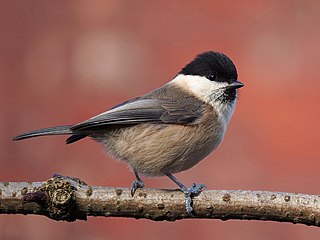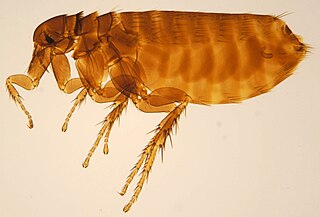
The willow tit is a passerine bird in the tit family, Paridae. It is a widespread and common resident breeder throughout temperate and subarctic Europe and across the Palearctic. The plumage is grey-brown and off-white with a black cap and bib. It is more of a conifer specialist than the closely related marsh tit, which explains it breeding much further north. It is resident, and most birds do not migrate.

The common moorhen, also known as the waterhen or swamp chicken, is a bird species in the rail family (Rallidae). It is distributed across many parts of the Old World.

The common gallinule is a bird in the family Rallidae. It was split from the common moorhen by the American Ornithologists' Union in July 2011. It lives around well-vegetated marshes, ponds, canals, and other wetlands in the Americas. The species is not found in the polar regions or many tropical rainforests. Elsewhere, the common gallinule is likely the most commonly seen rail species in much of North America, except for the American coot in some regions.

The Eurasian treecreeper or common treecreeper is a small passerine bird also known in the British Isles, where it is the only living member of its genus, simply as treecreeper. It is similar to other treecreepers, and has a curved bill, patterned brown upperparts, whitish underparts, and long stiff tail feathers which help it creep up tree trunks. It can be most easily distinguished from the similar short-toed treecreeper, which shares much of its European range, by its different song.

Pristidactylus is a genus of lizards from Chile and Argentina.

The guitarfish are a family, Rhinobatidae, of rays. The guitarfish are known for an elongated body with a flattened head and trunk and small, ray-like wings. The combined range of the various species is tropical, subtropical, and warm temperate waters worldwide.

Stentor, sometimes called trumpet animalcules, are a genus of filter-feeding, heterotrophic ciliates, representative of the heterotrichs. They are usually horn-shaped, and reach lengths of two millimeters; as such, they are among the biggest known extant unicellular organisms. They reproduce asexually through binary fission.

The moorhen flea is a flea originating from South America. It is now globally widespread. It is a large flea, easily identified because the male has two heavy horn-like spines on one of the genital flaps, and the female has a deep "bite" on the seventh sternite.
Dasypsyllus is a widespread genus of fleas. Some of its members are found in bird nests, including the moorhen flea, D. gallinulae.

Ceratophyllus gallinae, known as the hen flea in Europe or the European chicken flea elsewhere, is an ectoparasite of birds. This flea was first described by the German botanist and entomologist Franz von Paula Schrank in 1803.
Cnemalobus is a genus of beetles in the family Carabidae, containing the following species:
Dasypsyllus aemulus is a species of flea in the family Ceratophyllidae. It was described by Karl Jordan in 1933.
Dasypsyllus comatus is a species of flea in the family Ceratophyllidae. It was described by Karl Jordan in 1933.
Dasypsyllus stejnegeri is a species of flea in the family Ceratophyllidae. It was described by Karl Jordan in 1929.
Dasypsyllus lasius is a species of flea in the family Ceratophyllidae. It was described by Rothschild in 1909.
Dasypsyllus plumosissimus is a species of flea in the family Ceratophyllidae. It was described by Smit in 1976.
Dasypsyllus cteniopus is a species of flea in the family Ceratophyllidae. It was described by Karl Jordan and Charles Rothschild in 1920.

Myledaphus is a genus of Late Cretaceous cartilaginous fish whose fossils are known from Canada, the Midwest of the United States, Olmos Formation of the Difunta Group of Mexico, and the Beshtyubin and Bissekty Formations of Uzbekistan. It was a freshwater guitarfish that probably reached a length of 3 feet (91 cm), and had teeth adapted for a durophagous diet of animals such as clams. Most taxonomic authories place the genus in the Rhinobatidae. Two species are known: Myledaphus bipartitus, the type species, and Myledaphus araucanus, named in 2019.
Hygronemobius is a genus of insect in family Gryllidae.









